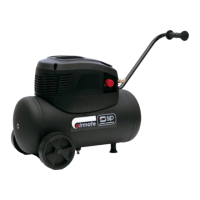1
Safety
DO NOT:
1. Use compressed air for cleaning clothing.
2. Apply compressed air directly onto the skin
3. Use compressed air for breathing apparatus or charging breathing air
cylinders, unless the air has been filtered using filters designed
specifically for this purpose.
4. Use an open-air line, this will cause ‘whip’ and could cause injury.
5. Use flammable liquids to clean the compressor.
6. Use naked flames to inspect the interior of the compressor or pressure
vessel.
7. Allow children or inexperienced people to operate or go near the
compressor.
8. Touch the air compressor with wet hands.
9. Move the compressor when in operation.
10. Move the compressor in any other method than the way in which it has
been designed.
DO:
1. Use eye protection when using compressed air to clean equipment.
2. Ensure dirt is not blown towards other people; always use a blow gun for
cleaning.
3. Ensure all ancillary equipment is in good condition and correctly rated for
the job.
4. Check regularly that covers and guards are secure and in position.
5. Fit a non-return valve or shut off valve in the delivery line if the
compressor is to be coupled in parallel with another compressor or
connected to an airline system.
6. Ensure that all pipe work and hoses connected to the compressor are the
correct size and suitable for the working pressure. Also in good condition.
7. Switch of the compressor and isolate from the mains supply and
discharge any stored air from the receiver or airline system, before
carrying out maintenance.
8. Install the compressor so that an adequate supply of cooling air can
circulate around the pump unit, and that air passage through the cover
and motor fan inlets is not restricted.
9. Ensure all safety rules and regulations are complied with, in all aspects
applicable to the working environment in which the compressor operates.
10. Always read the manual fully before operating this equipment.

